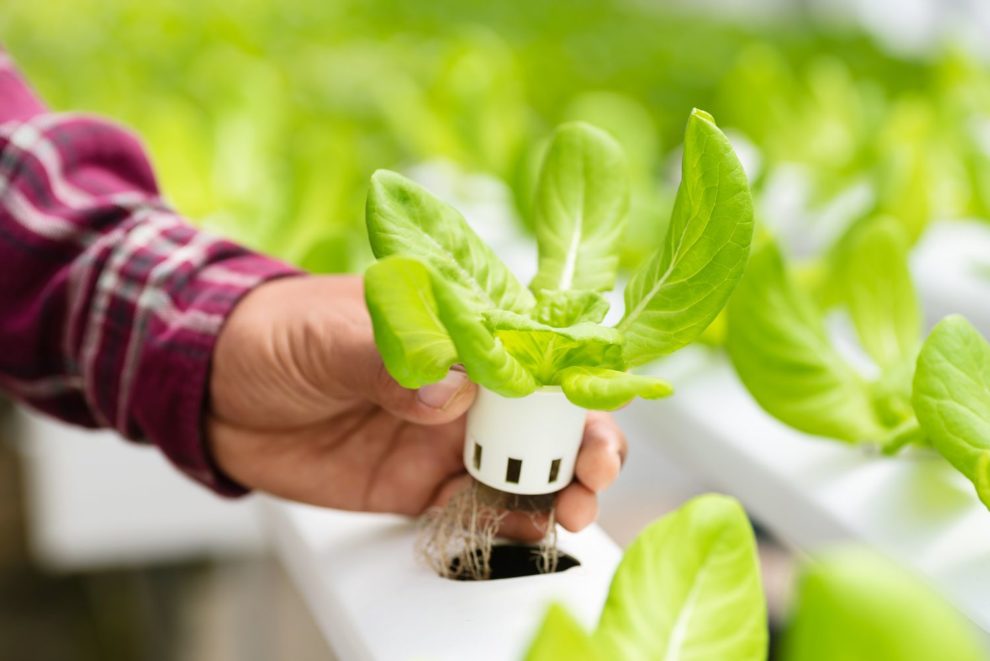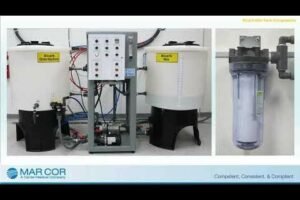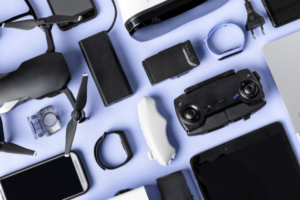Imagine the Empire State Building – one of the tallest buildings globally, standing proudly in New York City. Now visualize that very structure, its many floors compacted into just a couple – what if I told you such a revolutionary transformation is possible? Not with glass and steel, but with lettuce and tomatoes!
Welcome to the world of Hydroponic gardening. It’s like having an agricultural giant in your backyard or basement, only requiring a fraction of the space—and it all starts with something as small and unassuming as a hydroponic seed starter. Prepare to be immersed in this thrilling journey of growing your personal garden vertically, without soil, wherein every seed has the potential to reach towering heights! Get ready to redefine modern agriculture right at home.
Understanding Hydroponic Seed Starters
Hydroponic seed starters have become increasingly popular among gardeners because they offer a controlled and effective environment for growing plants, even in small spaces. Simply put, hydroponics is the process of growing plants without soil, using nutrient-rich water instead. Hydroponic seed starters are therefore containers filled with a growing medium and nutrient solution that allows seeds to germinate and sprout into baby plants.
One of the major advantages of hydroponic seed starting is that it allows you complete control over the growing conditions. You get to choose the type of seeds to use, the nutrients to provide, the lighting, and temperature conditions. This means that you can customize the environment to suit each particular type of plant that you want to grow. For example, some plants require more light than others while some prefer slightly cooler temperatures during the germination stage.
Starting seeds hydroponically also offers more freedom and choice in terms of plant varieties. Seeds are generally easier and more abundant to access than pre-grown seedlings. Additionally, some rare heirloom plants are only available as seeds. As such, starting your own seeds allows for a greater selection of unique plant types that may not be available at a local nursery or grocery store.
Starting with seeds is like writing a book from scratch – it offers endless possibilities for creativity and customization. You get to create something entirely unique from start to finish.
Now that we understand what hydroponic seed starters are and their benefits let’s delve into the key components and functions.
Key Components and Functions
The most important component of any hydroponic seed starter is the growing medium. This is what supports the root system while providing space for air to circulate around them. Common options include peat moss, coconut coir, rockwool, perlite, and vermiculite. Each of these materials has its own unique benefits and drawbacks, so it’s crucial to choose one that suits your specific needs.
Another essential component of hydroponic seed starters is the nutrient solution. This is what supplies plants with the essential minerals they need for healthy growth. Most nutrient solutions are pre-mixed and designed to meet the needs of different plant stages such as germination, vegetative growth, and flowering.
The container itself also plays a critical role in hydroponic seed starting. The container needs to be watertight to avoid leakage but still allow for proper airflow. It should also be opaque or have some form of light-blocking material around it to prevent light from penetrating the container and causing damage to the roots.
Apart from those three, lighting is another essential component of hydroponic seed starting. Since there is no natural sunlight indoors, artificial light sources are needed to sustain plant growth during all stages. Full-spectrum LED grow lights are arguably the most efficient option since they provide a balanced spectrum of light that mimics sunlight.
One potential drawback of hydroponic seed starting is that it requires more upfront investment compared to traditional soil-based gardening. You’ll need to purchase the growing medium, nutrient solution, containers, and lighting system. However, this cost can be offset by the fact that seeds are generally less expensive than pre-grown plants and starting with seeds allows for greater customization in terms of plant varieties.
Now that we’ve explored the key components and functions let’s move onto the pros and cons of seed starting hydroponically.
Pros and Cons of Seed Starting Hydroponically
Hydroponic seed starting is rapidly gaining popularity among gardeners globally. It involves growing plants without soil, often utilizing coco coir, peat moss, or rock wool as a growing medium and nutrient-enriched water solution to nourish tender roots. The benefits of hydroponic seed starting make it a preferred method for many gardeners. However, there are a few potential cons as well.
One major benefit of using hydroponic systems to start seeds is the complete control over every input that goes into the plants, including the type of seeds used. Using pre-grown seedlings restricts your varieties since you’re dependent on what’s obtainable locally. When you buy from online sources, you’ll pay more due to shipping costs, plus you need special permits for interstate commerce across the US. But when you start your seeds in hydroponic seed trays, your options expand considerably with an extensive selection of tomatoes, herbs, and peppers available from online distributors like Johnny’s Selected Seeds.
A critical point to consider when using hydroponic seed starters over traditional soil-based growing methods is the overall complexity of the system. The technology involved could be intimidating for beginners or those new to gardening world. Additionally, it will require consistent management and monitoring, such as pH balance and nutrient dosing, that some people might find time-consuming or costly.
Another benefit of using hydroponics is that starting with seeds rather than buying pre-grown seedlings offers more freedom and choice in the types of plants grown. Some rare heirloom plants are only available as seeds. If you’re searching for unusual or unique plants not found at local nurseries, then starting your own seeds may be the best option.
Think about it this way: imagine yourself at a big box home improvement store. You are looking for high-quality hardwood lumber to use for a woodworking project. Will you choose from the limited stock on the shelves, or will you look for someone who can cut to order from their inventory of premium-grade wood? When it comes to hydroponics, starting seeds from scratch provides the opportunity to access the best possible building blocks and ingredients for your garden and grow room.
One potential downside of using hydroponic seed starting is that new growers may not invest in adequate light sources or grow tents, which could lead to poor growth rates, reduced yields, or other issues such as slow germination rates. This problem is usually resolved by learning how to seek out quality equipment and expand your knowledgebase.
Now that we have highlighted some pros and cons of seed starting hydroponically let us turn our focus towards understanding optimal containers for seed germination.
Optimal Containers for Seed Germination
When it comes to hydroponic seed starters, choosing the proper vessel is essential for healthy plant development. Adequate drainage and appropriate size are two important factors to take into account when choosing a container.
One of the best types of containers to use for hydroponic seed starting is net cups with plastic covers. These allow roots plenty of air and space, while also protecting them from light deprivation until they’re ready for transplanting. Insert 2-3 seeds per cup; once sprouts emerge, thin down to one plant per cup.
While some people prefer using net pots on trays with drip irrigation systems, others utilize small rock wool cubes or peat pellets. The drawback with rockwool is that it’s not perfect for direct sowing but ideal as an intermediate planting medium before transplantation into larger containers with soilless mixes. Peat disks subjected to hydration might attract pests like insect gnats or diseases that hinder germination. Striking a balance between appropriate watering techniques and proper air exchange is key.
Whichever container you choose, whether it’s plastic or biodegradable ones made of bamboo that disintegrate over time, make sure they have proper drainage to avoid waterlogged seeds and fungal growth. Check the pH levels regularly too to keep them within optimal ranges. By doing so, not only are you safeguarding your seedlings but also guaranteeing maximum yield gains at harvest-time.
Another excellent option for hydroponic seed starting is shallow trays with clear covers that act as mini-greenhouses or grow domes. The cover helps retain moisture and humidity while protecting young sprouts from the light until roots form. These trays come in different shapes, sizes, and materials like the traditional black plastic flats used by nurseries or custom-designed polycarbonate domes that boost natural light diffusion.
Now that we have discussed which containers work best for hydroponic seed starting let us turn our focus onto nurturing baby plants in a water-based environment for the ideal results.
Nurturing Baby Plants in a Water-based Environment
One of the greatest benefits of using hydroponic seed starters is that they enable you to create a water-based environment that provides an ideal environment for plant growth. But nurturing baby plants in this kind of setup can be challenging. Here are some tips to ensure your seedlings thrive.
First, it’s important to avoid over-watering the plants. This is a common mistake many beginners make. Over-watering can lead to root rot, which can cause severe damage to the plants and even kill them. Always keep a close eye on the water levels and adjust accordingly.
Second, ensure that the temperature and humidity levels are appropriate for your plants. Different types of plants have different environmental requirements, so you need to do some research about what’s best for your particular plant. Generally, most plants prefer temperatures between 65-75°F and humidity levels of around 50-60%.
Third, be mindful of the lighting conditions in your growing space. Some plants require more light than others, so you need to ensure they get enough exposure without being burned by too much direct sunlight. Consider using LED grow lights specially designed for indoor gardens.
Fourth, think of your baby plants as if they were infants; they need gentle handling and care. When transplanting your seedlings into a larger hydroponic system or container, do it gently and with care not to damage their young roots.
Finally, consider using additional nutrients such as seedling fertilizer, which may give your young seedlings a head start towards healthy growth and faster maturation but should be used in moderation because too much can also harm them.
Essential Tips for Successful Sprouting.
Sprouting seeds require an optimal environment just like baby plants do, so it’s equally important to be mindful of critical factors.
Good-quality seeds are the foundation of any successful germination process. Make sure that you buy your seeds from reputable sources so that they meet quality standards, and take care not to damage them during the planting and germination process.
Ensure a consistent temperature between 70-75°F for optimal germination. You can use a seedling heat mat to regulate the temperature during the seedling stage. Avoid fluctuating temperatures, especially at night, as this can cause stress to your sprouts.
Use the right amount of water for germination; too much can drown your seeds, while too little stops them from developing roots. Prioritize using purified water as it doesn’t contain pathogens harmful to plants.
Like human babies, newly sprouted seeds may not require food or nutrients right away. Overfeeding with nutrients at an early stage can cause confusion and overgrowth, which means you need to wait until true leaves appear before feeding with a mild nutrient solution.
Finally, monitor the growth progress of your sprouts daily and look out for pests and diseases such as spider mites or fungus gnats. Early detection helps prevent the issue from escalating.
Remember, hydroponic gardening is about providing an environment in which plants thrives, but it still requires care and attention like any other gardening method. By understanding the key components and functions of hydroponic seed starters and adhering to these essential tips, you’ll be on your way to successfully nurturing thriving plants from sproutlings to full maturity.













